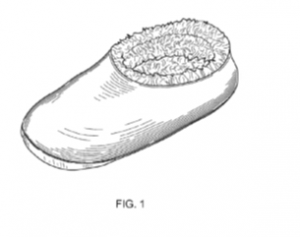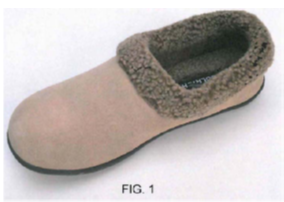“Ordinary Designer” Standard Should Be Used in Design Patent Obviousness Analysis
| October 24, 2013
High Point Design LLC, et al. v. Buyer’s Direct, Inc.
September 11, 2013
Panel: O’Malley, Schall, and Wallach. Opinion by Schall
Summary
This case addresses obviousness and functionality analysis for design patents. The CAFC stated that the obviousness of a design patent must be analyzed from the perception of a designer of ordinary skill in the field to which the design pertains. With regards to functionality, a design that can perform functions can be protected under design patent so long as the claimed design is “primarily ornamental” and not “primarily functional.”
意匠特許の自明性を判断する場合には、その意匠の分野の当業者の観点から分析を行うことが必要とされる。また、機能的な要素を有する意匠でも、その意匠が主として機能的ではなく、主として装飾的であれば、意匠特許の対象となる。
Details
Buyer’s Direct, Inc. (“BDI”) is the owner of U.S. Design Patent No. D598,183 (the “’183 patent”), for ornamental design of a slipper shown below:
High Point Design LLC (“High Point”) manufactures and distributes FUZZY BEAR® slippers shown below:
BDI became aware of High Point’s manufacturing and sales of the FUZZY BEARS®, and send a cease and desist letter, asserting infringement of BDI’s ’183 patent. High Point filed for declaratory judgment, alleging that FUZZY BEAR® did not infringe the ’183 patent, and that the ’183 patent is invalid and/or unenforceable.
The district court granted the motion for summary judgment filed by High Point, holding the ’183 patent invalid on the ground that the design claimed in ’183 patent was both (1) obvious in light of the prior art; and (2) primarily functional rather than ornamental.
BDI appealed.
(1) Obviousness
There are two steps in assessing the potential obviousness of a design patent: (1) find a single reference showing design characteristics which are basically the same as the claimed design; and (2) once the primary reference is found, other references may be used to create a design that has the same overall visual appearance as the claimed design.
The district court used the Woolrich Prior Art shown below as primary references:
The CAFC identified several ways in which the district court erred in conducting the obviousness analysis. First, the district court should have performed the obviousness analysis from the perception of a designer of ordinary skill in the field to which the design pertains. Next, in conducting the first step of the obviousness analysis, the CAFC stated, “the district court erred by failing to translate the design of the ’183 patent into a verbal description,” and that the district court need to add “sufficient detail to its verbal description of the claimed design to evoke a visual image consonant with that design.” Thirdly, the CAFC pointed that the district court failed to provide reasoning for choosing Woolrich Prior Art as a primary reference as required by precedent. Finally, the district court failed to address evidence of secondary considerations of commercial success of the claimed design as well as copying. Therefore, the CAFC reversed the grant of summary judgment of obviousness and remanded the case.
(1) Functionality
While the district court was required to analyze whether the claimed design was “primarily functional” or “primarily ornamental,” the district court incorrectly understood that it was required to determine “whether the design’s ‘primary features’ can perform functions.”
Because the district court applied an incorrect standard, the CAFC reversed the court’s ruling that the ’183 patent is invalid because of functionality.
Takeaway
Obviousness analysis requires consideration of a design from the viewpoint of an ordinary designer – one skilled in the art – not of an ordinary observer.
Tags: Design Patent > Functionality > obviousness






